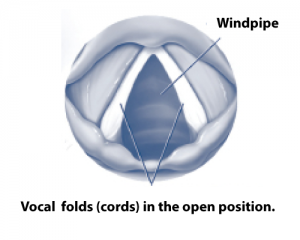Coordinated Onset
Simultaneous Onset, Balanced Onset
There are three main types of onset (attack) the aspirate onset, glottal onset and the coordinated onset (simultaneous onset). All three of these types of onset are used in singing all the time.
The coordinated onset is the piggy in the middle and has the best characteristics for singing of the three main onsets.
The aspirate onset starts with air flow and then the vocal folds are brought together to make the sound. The sound is often light and airy. With the glottal onset, the vocal folds are brought together before the air pressure is increased to a point where the vocals are blown apart to start phonation. This sound is often bright and very focused ( a very compressed sound).
In the coordinated onset, the air flow and the vocal folds are brought together at the same time. This gives a well-balanced connection or vocal focus that carries well and sounds the most like a natural speaking voice.
When to use a coordinated onset in singing?
The coordinated onset is used for middle to loud volume singing so in the context of you singing a song you would be singing most of your song in coordinated onset.
For the quieter singing you would go to the aspirate onset, and for the belting and screaming singing, you would go for a more focused vocal fold connection (glottal compression). So you would use the glottal onset.
Although we exercise these three onsets with warm ups and vocal exercises, when we come to sing the ultimate goal is just to sing with emotion. To let the voice respond to the will with which ever connection is appropriate.
Coordinated Onset Exercise
The best way to get this onset working is to start with the aspirate onset. To do this, we will start by saying hah (as at the beginning of the word heart). By doing this, we start the air flow that encourages an open throat. We will then slowly work on making the H quieter and quieter until you can’t hear it anymore. You should still be thinking H.
Have a listen to the recording below as I start with a little air at the beginning (aspirate onset also known as the soft onset) and then slowly take the air off the H until we are left with the coordinated onset. This is called the silent H onset and as you can here gives as a nice coordinated onset.
Coordinated Onset Exercise 1 (Simultaneous Onset)
Work along with the example until you are comfortable with this onset. Do this exercise on any pitch that feels comfortable to you first. Then work on the pitch that in the example above (Ladies will need to do this an octave higher). I always like to air on the side of slightly aspirated, but play around with it as there are many
I always like to air on the side of slightly aspirated, but play around with it as there are many variations between aspirated and glottal onset.
Coordinated Onset Exercise 2
Once you are comfortable with getting the coordinated onset on one pitch then it’s time to put it on a small scale. I like to start my students on Major 3rds and then transpose this up a semitone at a time. The pattern is 12321. Listen to it carefully first then do it along with the recording. Ladies will need to do this an octave higher.
make a point of learning the pattern so that you can use it when ever you like with out having to rely on having an .mp3 player handy.
Never start with the Glottal Onset
If you are a beginner then you shouldn’t start with the glottal onset. If you do you run the risk starting with a closed throat and will push to make the onset. This will make you scoop up to the pitch.
Practice this onset as much as possible for a well-balanced voice. When you go to talk after doing this onset, you will find that your singing voice and speaking voice feel great, smooth and clear. If it doesn’t then you may need to adjust what you were doing.
Note that onset work is like going down to the gym for a workout on your vocal folds. So you will need to start with little and often and then build it up from there. Always listen to your voice, it will tell you when it’s ready to do more or when you have over done it.
I hope that you found this article helpful?
[themify_box]You may find some of these interesting too:
The aspirated (soft) onset is the light intimate vocal onset. If you struggle with this type of singing then you might like to try this one.
All onsets need good breath support, learn how to monitor your breathing and how it’s different from normal breathing here.
[/themify_box]
Hi, I’m Dylan, I’ve been teaching people to sing professionally now for 20 years! I love my job and helping people to sing their very best.
That’s why I created this website (vocaltechnique.co.uk) to help people that want to teach themselves to sing or just want to know more about singing.
It’s been my pleasure to help all levels of singer to reach their singing dreams.
My new singing course “How the Singing Voice Works” is below. Check it out if your interested as I’m giving away a whole section of the course for free in the trial 🙂
P.S. If you want to find out more about your vocal folds then this is the right course for you 🙂


